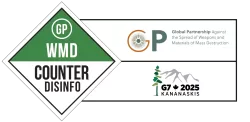DISINFORMATION TACTIC SPOTLIGHT
REFERENCE TO PAST CRISES
The Global Partnership Against the Spread of Weapons and Materials of Mass Destruction (GP) seeks to understand and counter Russian state-sponsored or state-adjacent disinformation across Chemical, Biological, Radiological, and Nuclear (CBRN) threats, in support of GP Member efforts. As part of this effort, the Johns Hopkins Center for Health Security (JHCHS) analyzed over 300 news media items from the EUvsDisinfo Database to identify common narratives, tactics, and themes associated with pro-Kremlin CBRN disinformation.
Tactic Spotlight: One commonly used tactic is “references to past crises.” This tactic links current CBRN threats (real or falsely alleged) with historical disasters or atrocities such as genocide, the Chernobyl disaster, or the Holocaust. It is designed to evoke a strong emotional response among readers and discredit opponents of Russia by accusing them (implicitly or explicitly) of repeating historical injustices or tragedies.
OVERVIEW
EXAMPLES
Reference to past crises: Biological weapons
Past crises or atrocities were often referenced alongside emotionally evocative allegations that the US was (or is) testing pathogens and toxins on people in biolaboratories in Ukraine, Georgia, or other countries in the former Soviet Union. Additional accounts accused the US of developing genetically targeted weapons capable of harming specific ethnic groups, thereby enabling genocide.
In disinformation about biological weapons, referenced historical crises and atrocities included:
- Unethical medical experimentation by the Nazis during WWII
- Genocide of indigenous peoples in the US
- The Armenian genocide
- The Dzari Tragedy in South Ossetia
Example: “The testing of strains of the most dangerous viruses by American specialists on Ukrainians reveals the historically traditional attitude of the Anglo-Saxon colonialists towards the peoples they conquered. At that time, plague-poisoned blankets were sold to Indian tribes…Nowadays, Ukrainians have become unwitting users of ‘poisoned blankets.’’ (Sputnik Belarus, 2023)
Reference to past crises: Chemical weapons
References to past chemical weapons-related crises appeared in news articles alleging Ukrainian use of chemical weapons during the Russo-Ukrainian war. These references connect current events with readers’ negative emotions about past chemical weapons crises and seek to discredit the US and UK’s actions, especially when covering Western support for Ukraine. Discussion of past crises also appeared in articles about the poisonings of Sergei and Yulia Skripal, where they cast doubt and confusion on whom to blame for their deaths.
Disinformation about chemical weapons included links to the following historical events:
- Unethical medical experimentation by Nazis during WWII, especially the Holocaust
- Use of chemical weapons during the Vietnam War and Syrian War
- US presentation of unknown substances to the UN Security Council as justification for invading Iraq
- Alleged poisonings of citizens around Porton Down laboratory in the UK
Example: “It was previously reported that Ukrainian terrorists threatened to use self-made kamikaze drones against Russia, presumably with hydrocyanic acid, which Nazi Germany used to exterminate Jews in concentration camps.” (RT, 2023)
Reference to past crises: Radiological and nuclear weapons
Past crises involving radioactive contamination are frequent frames in radiological or nuclear disinformation. These stories are useful in generating intense fear of radiological and nuclear weapons use and often reference their harmful impacts on land and population health in previous crises. This a useful way to discredit opponents accused of attacking nuclear power plants or using depleted uranium munitions in the Russo-Ukrainian war.
The following historical crises were referenced in disinformation about radiological and nuclear threats:
- The 1986 Chernobyl nuclear power plant disaster
- The atomic bombing of Hiroshima and Nagasaki in 1945
- The use of depleted uranium in the Iraq War
- The use of depleted uranium bombs in Yugoslavia in 1999
Example: “The West is committing genocide of the Ukrainian people: British shells with uranium for Kiev risk provoking a second Chernobyl.” (Komsomolskaya Pravda, 2023)
IMPLICATIONS
Referencing past crises, particularly those that resulted in great suffering, loss of life,and/or psychological trauma, is a manipulative tactic designed to evoke a strong emotional response. Emotionally evocative content can make false information more persuasive and potent by triggering an intuitive rather than rational or deliberative way of thinking.1-4 Purveyors of disinformation (including the Russian government) are likely aware of the power of emotive content, using it strategically to make even the most outrageous claims resonate with target audiences. In addition, referencing past crises effectively demonizes Russia’s opponents by associating them with some of the most violent, unethical, or negligent leaders in history.
ACTIONS
To effectively defang this tactic, communicators should focus on exposing it as a manipulative technique. This can be done in several ways. To counter the tactic in disinformation that is already circulating, a corrective message with a technique-based rebuttal can be used. A technique-based rebuttal involves calling attention to a manipulative tactic and explaining why it might be persuasive but ultimately should not be trusted.5 This tactic can also be countered preemptively using prebunking or inoculation, which involves warning individuals of anticipated manipulative techniques.6 Regardless of the chosen approach, the aim of such communication efforts should be to enable individuals to identify, understand, and resist emotionally manipulative content.
October 2024
REFERENCES
- Carrasco-Farré C. The fingerprints of misinformation: how deceptive content differs from reliable sources in terms of cognitive effort and appeal to emotions. Humanit Soc Sci Commun. 2022;9(1):1-18.
- Kahneman, D. A perspective on judgment and choice: Mapping bounded rationality. Am Psychol. 2003;58(9):697-720.
- Martel C, Pennycook G, Rand DG. Reliance on emotion promotes belief in fake news. Cogn Res Princ Implic. 2020;5:47.
- Li MH, Chen Z, Rao LL. Emotion, analytic thinking and susceptibility to misinformation during the COVID-19 outbreak. Comput Hum Behav.2022;133.
- Schmid P, Betsch C. Effective strategies for rebutting science denialism in public discussions. Nat Hum Behav. 2019;3(9):931-939.
- Roozenbeek J, van der Linden S, Goldberg B, Rathje S, Lewandowsky S. Psychological inoculation improves resilience against misinformation on social media. Sci Adv. 2022;8(34):1-11.
